Splitting User Stories Across Teams
I recently received a question by email wondering if large user stories should be split across teams. The question was so interesting that I thought I would summarize my response here. Sometimes large…
How to Best Slice User Stories
Splitting large stories into smaller stories is one of the best things a team can do to improve their workflow. But how do we split these stories?
Themes versus Epics in 2 Minutes
The difference between themes and epics are a common sticking point for many teams first diving in to user stories. Not only can descriptions of both topics often be vague, but the difference is often muddled further by many project management tools that use the two terms interchangeably. However, the difference doesn’t have to be so hard.
Stop Estimating Spikes!
The most common question that teams face when first working with spikes is whether or not to estimate these stories. Luckily the answer is simple...don't.
The whole point of spikes is to help us learn more about stories that we don't yet know enough about to estimate well. This very unknown nature means that estimating the spike itself would be fruitless. Instead, our goal is to learn enough during the spike that we can estimate the associated story in an upcoming sprint.
Using Personas to Give Backstories to Your Users
You already know that roles are crucial to any User Story since they help us put context around who a given feature is for. However, did you know that you can also put context around your roles?
Meet the Timestamp Sticky
It’s no secret that teams who track their progress using physical tools rather than electronic have have a much higher rate of success, but how do you handle of the fear of sticky notes falling off the wall?
Stories versus Themes versus Epics
When a new team is just beginning to adopt Scrum the difference between stories, themes, and epics always seem to be a source of some confusion. In particular, where stories end and epics begin tends to be a particular sticking point. In this article, we’ll take a closer look at each artifact to get a better understanding of the subtle differences between them so we can better communicate to our teams when each is appropriate for the work at hand.









